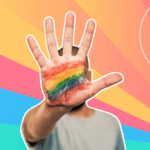Photo: Igor Alecsander/Getty Images
By Samuel Malave Jr, Creative Insights Manager, iStock and Getty Images
Hispanic. Latino/a. Latinx. There are a bevy of terms that are used to refer to US descendants of Latin American countries. Latino/latina have been the most popularized, but in recent years there has been an effort to be more gender inclusive with the use of “Latinx.”
This group represents a large swath of the American population: 18.9%, to be exact (of which millennials account for 22%).1 Being such a sizable portion of the population has major implications: Hollywood is portraying notable superheroes like Spiderman and America Chavez as being of Latin American descent while Spotify’s biggest artist of 2022—Bad Bunny—is a Puerto Rican rapper.2
This presence (which is still growing) has strong marketing implications, too. According to a University of Houston study, Latinx consumers’ annual buying power reached $1.72 trillion in 2020 and is expected to exceed $2.5 trillion in the next two years.3 The community’s swelling economic impact, combined with the eagerness of pop-culture to reflect Latinx culture, has created a consumer base that is empowered–they are seeing Latinx artists and stories succeeding because of, and not despite, their differences. And, as will be noted later on, they aren’t afraid to buck up against convention if they don’t feel seen. Brands and businesses run the risk of falling behind with an influential audience if they don’t take advantage of this momentum. It is imperative, then, that they understand how to make visual choices that engage and appeal to the millennial audience’s sensibilities.
Tell real stories that uplift and celebrate
Despite being almost 20% of the population, Getty Images’ and iStock’s VisualGPS research shows us that only 5% of popular images from 2022 feature Latinxs. Even further, millennials only make up 9% of images of Latinxs. This disparity aligns with further VisualGPS data that tells us Latinxs see more of themselves on social media than in traditional media, but there does seem to be interest among brands to combat the lack of nuanced representation and portray the Latinx community more authentically. While broad searches using terms like “hispanic,” “latino,” and “Latinx” declined in 2022, more specific searches like “hispanic elderly” and “hispanic small business owner” increased 444% and 255%, respectively. Additionally, searches for “afro latino” increased significantly (230%), signaling an appetite to shine more light on a crucial, oft-forgotten segment of the community: Black Latinxs.4
This appetite on behalf of brands and businesses to move beyond blanket terms makes sense in the broader context: it is no surprise that gender-inclusive terms “Latinx” reached critical mass while millennials were coming of age. If nothing else, this cohort values being represented honestly and with consideration for all.
Show togetherness
VisualGPS research also tells us that “spending more time with family/friends/loved ones” is one of the most important things to Latinxs. We see this sentiment echoed in visuals choices, as well. Among the most downloaded images of Latinxs in 2022, almost 20% revolve around the topic of family (compared to 13% of images of other ethnicities).5 This is even echoed in popular culture, where Disney’s massive successes Coco and Encanto explicitly deal with Latinx protagonists navigating fraught intra-familial relationships and growing closer to their loved ones as a result.
One area where the themes of family and togetherness are especially present is queerness. The topic of chosen family is a cornerstone of the queer experience, and the rise of New York City’s underground voguing scene through shows like HBO Max’s Legendary is proof of this, specifically for Black and/or Latinx queer folks. The ballroom scene has given queer people of color a way to model familial relationships that may have been denied them because of homophobia and transphobia. Getty Images and iStock visuals also stress this need for chosen family: while 30% of the top images of Latinxs feature groups of people, that number skyrockets to 78% when Latinx trans folk are featured.6
Move past stereotypes
On that note, machismo is another theme to keep in mind when representing the Latinx community visually. According to the Cambridge dictionary, machismo is defined as “male behavior that is strong and forceful and shows very traditional ideas about how men and women should behave.” Machismo limits the emotional spectrum of folks within the Latinx community in favor of a stoic and problematic expression of masculinity. This was why it was powerful to see Mahershala Ali’s depiction of Juan, an Afro-Cuban, in 2016’s Moonlight: although he could easily be labeled as a stereotypical macho man, he was able to create an emotionally vulnerable and judgement-free space for a child struggling with his queer identity.
Getty Images and iStock customers are also challenging the macho stereotype through their visual choices. When it comes to displays of emotion or images of domestic life, men are featured prominently (45% and 48%, respectively), upending more traditional notions of manhood. However, despite straight men being given access to a broader range of expression, gay men only account for 1% of the top Latinx images.7 So, while machismo seems to be evolving for men overall, sexuality is still an area where its presence is felt.
Latinx millennials are poised to have tremendous economic impact over the coming years and it is imperative to keep these visual considerations top of mind as you think about marketing to them: go a step further than surface-level representation by acknowledging the differences that exist within the community; keep in mind the importance of family (and not just blood-relatives); make sure to hold space for marginalized identities that can benefit from increased visibility.
- [1] US Census Bureau QuickFacts https://www.census.gov/quickfacts/fact/table/US/PST045222
- [2] SPOTIFY | 2022 Wrapped – Bad Bunny Artist of the Year SPOTIFY | 2022 Wrapped – Bad Bunny Artist of the Year; https://blog.playstation.com/2021/10/08/marvels-spider-man-miles-morales-an-homage-to-hispanic-heritage-and-representation/
- [3] “Online shopping orientations of Latino millennial generational cohorts”, November 2022, (University of Houston) https://onlinelibrary.wiley.com/doi/10.1002/cb.2107
- [4] Getty Images VisualGPS
- [5] Getty Images VisualGPS
- [6] Getty Images VisualGPS
- [7] Getty Images VisualGPS







